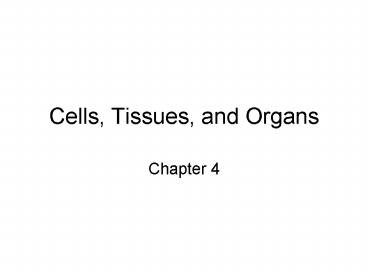Cells, Tissues, and Organs - PowerPoint PPT Presentation
1 / 34
Title:
Cells, Tissues, and Organs
Description:
Cells, Tissues, and Organs Chapter 4 Modern Cell Biology Makes 6 Assumptions: All living material is made up of cells or products of cells All cells are formed from ... – PowerPoint PPT presentation
Number of Views:40
Avg rating:3.0/5.0
Title: Cells, Tissues, and Organs
1
Cells, Tissues, and Organs
- Chapter 4
2
Modern Cell Biology Makes 6 Assumptions
- All living material is made up of cells or
products of cells - All cells are formed from previously existing
cells - -cell division
- -fusion of sperm and egg
- 3. Most elementary unit of life
3
- 4.Every cell is bound by a plasma membrane
- 5. All cells have strong biochemical similarities
- 6. Most cells are small
- -.001cm (.00004 inches) in length
4
3 functions of most cells
- Maintenance
- Synthesis of cell products
- Cell division
5
Cell Membrane
- Encloses the cell
6
Cytoplasm
- Material in the cell membrane that contains
organelles and granules in suspension
7
Examples of organelles
- Golgi apparatus
- Nucleaus
- Ribosomes
- Centrioles
- Microfilaments
- Microtubles
- Lysosomes
- Storage particles
8
Plasma Membrane
- Cells are surrounded by this thin membrane of
lipid (fat) and protein - Controls the transport of molecules in and out of
the cell - Serves as the boundary between the cell and
surrounding tissue
9
Nucleus
- Enclosed by a nuclear envelope, or membrane, with
pores
10
Nucleoli
- Discrete structures in the nucleus
- Site of RNA synthesis
11
Chromosomes in the nucleus
- Contain DNA
- Carries hereditary information
12
The nucleus directs the activity of the cell
- Example information is transcribed into the RNA,
which serves as a messenger. Messenger moves out
of the nucleus to the ribosome where it guides
the synthesis of protein.
13
Ribosomes
- Made of RNA and protein
- Site of protein synthesis
14
Endoplasmic Reticulum
- A complex set of membranous structures
- Rough or smooth
- Rough large amounts of protein
15
Golgi Body
- Membrane mixture found near nucleus
- Accumulates secreted lipids and proteins
16
Mitochondria
- Almost all of the energy passes through this
molecule before being used in cell function
17
Microfilaments
- Long, thin rods that contract
- Responsible for movement of cells
18
Lysosomes
- Large number of enzymes are stored
19
Morphogensesis
- Process of cell development
- Each cell contains the same total genetic
information that was present in the fertilized
egg - Cells arent identical because genes are
controlled (switched on and off) by various
biochemical processes
20
Cell Division Depends On
- 1. copying of DNA
- 2. orderly separation of the products of this copy
21
Chromatids
- Each chromosome contains two sister chromosomes
called this
22
6 Stages of Mitosis
- Prophase
- Prometaphase
- Metaphase
- Anaphase
- Telophase
- Interphase
23
Prophase
24
Metaphase
25
Anaphase
26
Telephase
27
Interphase
28
Meiosis
- Produce gametes (sex cells)
- 2 cell divisions
- Reduce number of chromosomes
29
(No Transcript)
30
Meiosis Stages
- Prophase with 5 sub-stages
- Prometaphase
- Metaphase
- Anaphase
- Interphase
31
- Only one in four of the female gametes is
functional because the division of cytoplasm is
unequal - The functional ovum requires more cytoplasm to
serve as food for the developing ovum - Fertilization restores the cell to the original
number of chromosomes which was reduced during
meiosis - Humans 46 chromosomes
- Horse 64 chromosomes
32
DNA consists of 3 components
- Deoxyribose sugar
- Phosphate
- 4 nitrogen bases
- A Adenine
- T Thymine
- G - Guanine
- C - Cytosine
33
Tissue
- Structured groups of cells specialized to perform
a common function necessary for the survival of
the horse
34
Classification of Tissues
- Nerve
- Epithelial (cover external and cushion internal)
- Muscle (cardiac)
- Connective (tendons and ligaments)
- Fluid (blood and lymph)































